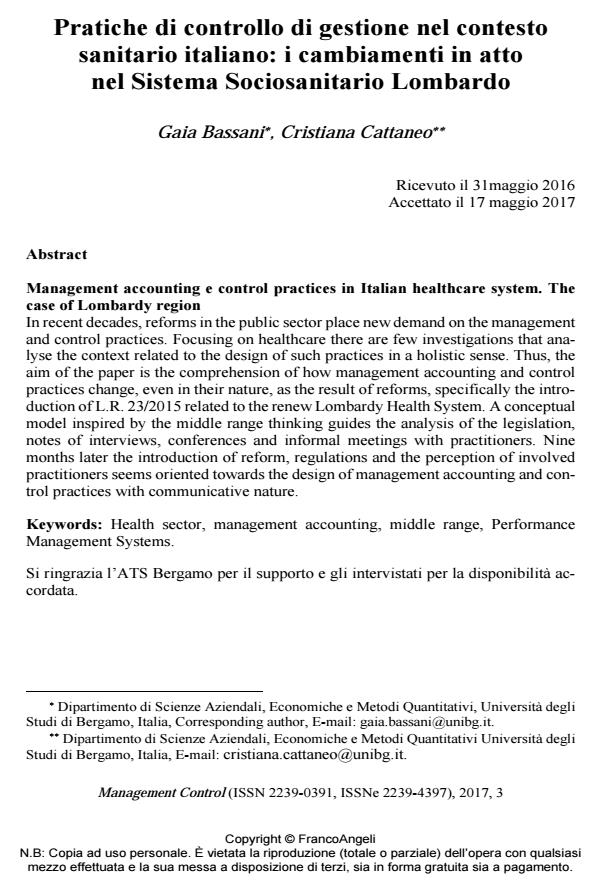Pratiche di controllo di gestione nel contesto sanitario italiano: i cambiamenti in atto nel Sistema Sociosanitario Lombardo
Titolo Rivista MANAGEMENT CONTROL
Autori/Curatori Gaia Bassani, Cristiana Cattaneo
Anno di pubblicazione 2017 Fascicolo 2017/3
Lingua Italiano Numero pagine 19 P. 11-29 Dimensione file 228 KB
DOI 10.3280/MACO2017-003002
Il DOI è il codice a barre della proprietà intellettuale: per saperne di più
clicca qui
Qui sotto puoi vedere in anteprima la prima pagina di questo articolo.
Se questo articolo ti interessa, lo puoi acquistare (e scaricare in formato pdf) seguendo le facili indicazioni per acquistare il download credit. Acquista Download Credits per scaricare questo Articolo in formato PDF

FrancoAngeli è membro della Publishers International Linking Association, Inc (PILA)associazione indipendente e non profit per facilitare (attraverso i servizi tecnologici implementati da CrossRef.org) l’accesso degli studiosi ai contenuti digitali nelle pubblicazioni professionali e scientifiche
In recent decades, reforms in the public sector place new demand on the manage-ment and control practices. Focusing on healthcare there are few investigations that analyse the context related to the design of such practices in a holistic sense. Thus, the aim of the paper is the comprehension of how management accounting and control practices change, even in their nature, as the result of reforms, specifically the introduction of L.R. 23/2015 related to the renew Lombardy Health System. A conceptual model inspired by the middle range thinking guides the analysis of the legislation, notes of interviews, conferences and informal meetings with practitioners. Nine months later the introduction of reform, regulations and the perception of involved practitioners seems oriented towards the design of management accounting and control practices with communicative nature.
Parole chiave:Health sector, management accounting, middle range, Performance Management Systems.
- Orientamento al feedback, soddisfazione rispetto al feedback del sistema reporting e performance di budget Manuela S. Macinati, Marco Giovanni Rizzo, in MANAGEMENT CONTROL 3/2024 pp.179
DOI: 10.3280/MACO2024-003009 - Soddisfazione lavorativa e work engagement nelle budgeting practices delle aziende sanitarie pubbliche. Una verifica empirica Domenico Raucci, Manuela Paolini, in MANAGEMENT CONTROL 1/2021 pp.13
DOI: 10.3280/MACO2021-001002 - Il reporting per segmenti nei settori del trasporto pubblico locale e della cura della salute. Esperienze a confronto Domenico Nicolò, Giuseppe Valenza, in MANAGEMENT CONTROL 1/2020 pp.35
DOI: 10.3280/MACO2020-001003 - Informazioni budgetarie e prospettive di Behavioral Management Accounting nelle aziende sanitarie pubbliche italiane Domenico Raucci, Manuela Paolini, in MANAGEMENT CONTROL 2/2022 pp.117
DOI: 10.3280/MACO2022-002006 - Il cambiamento dei sistemi di controllo manageriale e il processo di successione nelle imprese familiari. Quali possibili relazioni? Francesca Maria Cesaroni, Annalisa Sentuti, in MANAGEMENT CONTROL 1/2019 pp.17
DOI: 10.3280/MACO2019-001002
Gaia Bassani, Cristiana Cattaneo, Pratiche di controllo di gestione nel contesto sanitario italiano: i cambiamenti in atto nel Sistema Sociosanitario Lombardo in "MANAGEMENT CONTROL" 3/2017, pp 11-29, DOI: 10.3280/MACO2017-003002